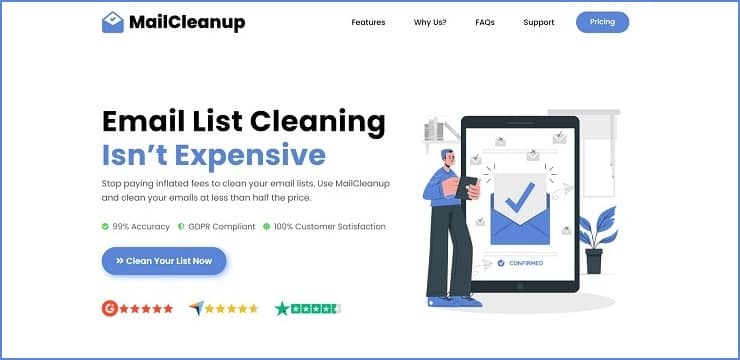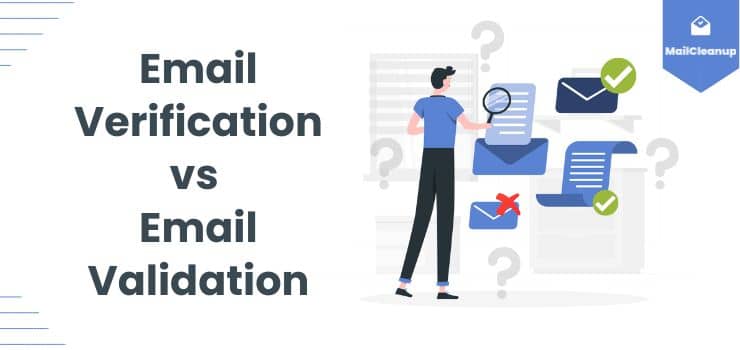If you are looking to understand the difference between email Verification vs email Validation, you have arrived at the right blog post.
You see, email marketing is still one of the most effective marketing strategies for businesses.
However, one of the biggest challenges that email marketers face is reducing bounce rates. Bounce rates occur when an email is not delivered successfully to the recipient’s inbox.
Email verification and email validation are two methods that marketers can use to reduce bounce rates. But which method should you opt for? I bet you are wondering if they are same. Well, let us tell you, they are not…
In this article, we will discuss the differences between email verification and email validation, their pros and cons, and how to choose the right software that offers these services.
Let’s start with the basics…
Email Verification vs Email Validation: The Definitions
What is Email Verification?
Email verification is the process of verifying the validity and deliverability of an email address.
It involves checking if an email address is syntactically correct, whether the domain exists, and whether the mailbox can receive messages.
Email verification helps to ensure that the emails you send reach your intended audience and that you don’t waste resources sending emails to invalid email addresses.
What is Email Validation?
Email validation is the process of verifying the quality of an email address.
It involves checking if the email address is valid, active, and engaged. Email validation helps to ensure that the emails you send are not marked as spam and that your email campaigns are effective.
Key Differences Between Email Verification & Validation
Email verification and email validation are often used interchangeably, but they are two different processes.
Email verification helps to ensure that emails are delivered to the intended recipient’s mailbox, whereas email validation helps to ensure that the emails are delivered to an active and engaged recipient.
Email verification checks the syntax of an email address, domain existence, and mailbox existence, while email validation checks the activity of the email address, email engagement, and spam complaints.
Pros & Cons of Email Verification
Pros of Email Verification
- Reduces bounce rates: Email verification helps to ensure that emails are delivered to the intended recipient’s mailbox.
- Saves time and resources: By eliminating invalid email addresses, email verification saves time and resources that would be spent sending emails to non-existent email addresses.
- Increases email deliverability: Email verification helps to ensure that the emails you send are delivered to the intended recipient’s mailbox, which increases email deliverability.
Cons of Email Verification
- Does not guarantee engagement: Email verification only checks if an email address is valid and if the mailbox can receive messages. It does not guarantee that the recipient will engage with your email.
- May not catch all invalid email addresses: Some email verification services may not catch all invalid email addresses, which can result in bounce rates.
Pros & Cons of Email Validation
Pros of Email Validation
- Increases email engagement: Email validation helps to ensure that the emails you send are delivered to an active and engaged recipient.
- Reduces spam complaints: Email validation helps to ensure that the emails you send are not marked as spam.
- Increases email deliverability: Email validation helps to ensure that the emails you send are delivered to an active and engaged recipient, which increases email deliverability.
Cons of Email Validation
- May result in false positives: Email validation may flag some email addresses as invalid, even though they are valid, resulting in false positives.
- May not catch all inactive email addresses: Some email validation services may not catch all inactive email addresses, resulting in lower engagement rates.
How to Perform Email Verification or Email Validation?
Manually performing email verification and validation is extremely challenging, laborious, and time-consuming.
Not only do you have to check for any syntax error but you’d also have to check domain validity, among other things. Manually sending SMTP pings is very difficult.
And, when you have a database of millions of email addresses, it would be impossible for you to manually perform email validation or verification.
To offer you a simpler and faster solution, there are several email verification and email validation services. These software or apps can complete your entire process in a few minutes or a few hours.
But now, the question arises, which software should you pick? Here’s a checklist of a few things that you should keep in mind before purchasing its credits…
How to Choose the Right Email Verification & Validation Service?
When choosing an email verification or validation service, there are several factors to consider –
- Accuracy: Choose a service that has high accuracy rates in identifying invalid or inactive email addresses.
- Speed: Choose a service that can verify or validate email addresses quickly.
- Cost: Choose a service that fits within your budget.
- Integration: Choose a service that integrates with your email marketing platform.
List of Best Email Verification & Email Validation Services
Here’s a list of some of the top email verification or validation services that you can rely on…
1. MailCleanup

MailCleanup is an email verification and validation service that checks for invalid, inactive, or catch-all email addresses. We employ several measures to find and remove invalid email addresses from your email lists.
As a result, we are able to offer up to 99% email verification accuracy and that too at less than half the price.
Our cheapest plan starts at $5 for 1,000 credits and goes up to $500 for 1 million credits.
2. NeverBounce
NeverBounce is another email verification and validation service that helps to reduce bounce rates.
NeverBounce offers a real-time verification service that is both affordable and accurate.
The pricing starts at $8 for 1,000 credits.
3. ZeroBounce
ZeroBounce is one of the most experienced and robust email verification and validation service in the email marketing sector.
It helps to reduce bounce rates and increase deliverability. ZeroBounce offers real-time email verification services with an accuracy rate of 98%.
Its pricing starts at $16 for 2,000 credits.
4. BriteVerify
BriteVerify offers fast and reliable email validation services with an accuracy rate of up to 98%.
It pricing plans will start at $40 for 5,000 credits.
5. MailboxValidator
MailboxValidator is another fast and accurate email validation service with a 97% accuracy rate.
The software uses multiple email verification measures and its pricing plans start at $19.95 for 1,000 credits.
6. Xverify
Xverify provides fast and reliable email validation through integration with over 200 popular email marketing platforms.
You can start with Xverify as its pricing starts at $10 for 1,000 verification credits.
7. Bouncer
Bouncer offers fast and accurate email validation with a 98% accuracy rate. It is also helpful in removing spam traps from your email list.
The pricing of Bouncer starts at $7 for 1,000 credits.
Best Practices to Maintain Email List Quality
To ensure the quality of your email database or email lists remains high, we encourage you to follow these best practices –
- Use double opt-in: Use double opt-in to ensure that your email list only includes active and engaged subscribers.
- Regularly clean your email list: Regularly clean your email list to remove invalid, expired, or inactive email addresses.
- Segment your email list: Segment your email list to improve email engagement and deliverability.
- Use personalization: Use personalization to increase email engagement.
Conclusion
We hope that you now understand the difference between email verification vs email validation.
In conclusion, both email verification & validation are important processes for businesses to ensure that their email marketing efforts are effective and efficient.
While email verification focuses on verifying the existence of an email address, email validation goes a step further by verifying the quality and deliverability of an email address.
Ultimately, the choice between email verification and email validation depends on the specific needs and goals of a business.
For businesses that are primarily concerned with verifying the existence of email addresses, email verification may be sufficient. However, for businesses that want to ensure that their emails are reaching engaged and active subscribers, email validation is the superior choice.
By investing in email validation, businesses can improve the effectiveness and efficiency of their email marketing campaigns, leading to better engagement, higher conversion rates, reduced bounce rates, and ultimately, increased revenue.
Lastly, here are other posts that you may want to read –
